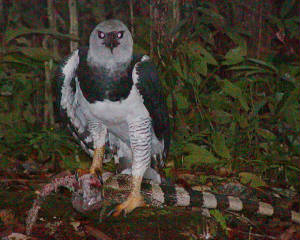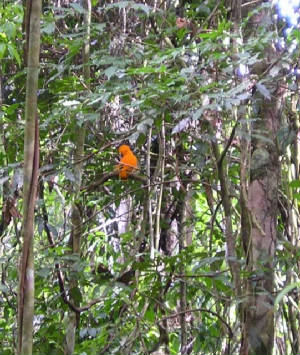|

|
| photo by Adam Reeck, 2004 |
Harpy Eagle
The name harpy comes from a Greek myth about monsters that are half woman and half
bird. When harpy eagles are alerted feathers stick up on top of their heads looking very disorderly and menacing. Harpies
are one of the biggest and fiercest of the 59 species of eagles. They are found in tropical South American forest aften near
river banks. Harpies have black wings, white belly and breast, a grayish head and tails that are striped black and brown.
Male and female harpies look alike in every way except in size. The female is slightly bigger, about a yard 9almost 1 meter)
from head to tip of tail. This 20lb bird can fly at a speeds of 50mph. Harpies eat sloths, monkeys, other birds, and lizards.
Harpies catch their prey by circling, diving and gripping them with their strong talons.
The talons are 5 inches long and strong as a grizzly claws. They make big nests 4ft in diameter at heights of 90ft
in the canopy. The nest may be used for a pair’s 20 year reproductive span. Harpies may successfully raise only a few chicks as the offspring require two years
of parenting. Usually 2 eggs are laid but only one hatches because the first one to hatch pushes the other egg out of the
nest. The harpy hatches 30 days after the eggs are laid. During the first six weeks the male brings food to the female and
baby. At 4 weeks of age the chick begins to exercise by jumping up and down in their nest; at 6 or 7 months it takes short
flights; at 12 months it begins to hunt and is finally ready to leave the nest at 18 months.
There is a harpy nest nearby so we occasionally see them; they sometimes bring
prey to the island to eat it.
------- by Pascal, February, 2005
|
 |
|

|
| photo by Phil Friedman, 2005 |
Cock-of-the-Rock
The cock-of-
the -rock is the brightest bird in the rainforest. They live deep in the rainforest in the understory near the cliffs and
rocks. They make their mating grounds on the forest floor, which is called a lek. The female's color is a dark uniform
ashy-brown with a rudimentary, frontal crest that is dark orangey-brown. The male cock-of -the rock is a brilliant orange
bird with a large crest that extends between the eyes. The lek is where the males
hang out, perched on a low branch above the patch of ground that they have cleared about 4 feet wide.) For food they eat nearby
fruit. When it is mating 20-30 or more males gather around the lek waiting for
a females to come. When one comes they all try to impress her by spreading their
feathers and tilting their heads sideways to show off the large round crest of feathers. The male watches the female with
one eye and does a little dance for her. The females are very hard to impress. A few males get to do most of the mating.
The females build nests on the cliffs of
mud that blend in with the rocks. The females coloring is dark so she also is
camouflaged. She raises the young alone.
Birds that eat fruit take longer to grow up because they do not eat a lot of protein.
-----by OMAR, February
2005
|
 |
|
|
 |
|
|
|

